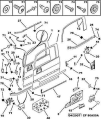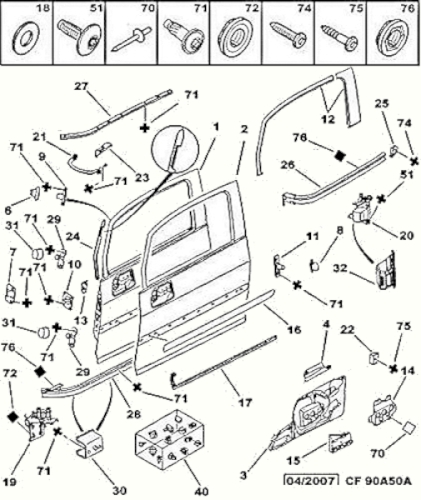
How the Doors Work

The sliding doors sometimes get a bad press - simply because they are different. But remember that 90% of problems are due to the in-door actuator ; another 5% are due to the B-post actuator ; another 4% are due to dirty contacts at the front edge of the doors leaving just 1% for other faults.
Avoid forcing the doors manually as it COULD stretch the cables and MIGHT cause the slack to jam on the motor drum or over-rev the drive motor. Should the electrics fail, just use sufficient force to get the door moving; no more. This includes garage mechanics!
I think this is the way the sliding doors work:
When you send a signal to OPEN the door, the actuator in the door (the one which often fails) pulls a cable inside the door to release the rear latch. There is an electrical contact (either on the rear latch or on the multi-contact at the front of the doors) which tells the control unit it has released. The Control Unit then tells the B-post actuator (the rear latching loop) to push the back of the door out and also powers the main door motor to open the door.
The B-post actuator (the rear latching loop) remains extended ready for the final pull-in action when the door is closed (you can see this from inside the car). So you should hear TWO actuators working when the door opens.
The door then continues to open until the microswitch at the back of the door is operated - this is operated by a simple sprung lever that pushes on a flap that in turn presses on the microswitch. This stops the main motor running.
If the microswitch doesn't operate when the door opens fully, the door continues opening until it meets a resistance and then closes.
To CLOSE the door, the main door motor is operated until the multi-contacts on the front of the door make. When the door is almost closed, the mechanical latch at the back of the door latches on to the loop of the B-post actuator (in a similar manner to the way a normal car door latch works).
The in-door actuator doesn't operate at this time however the multi-contacts tell the Control Unit that the door is almost closed and activate the B-post actuator which then pulls the back of the door in tight.
Advanced from Yves De Muyter
You also have to understand, if the door ECU finds an error-condition, it will place your door in fail-safe mode and will stop working in automatic mode. Connecting the Peugeot PP2000 test equipment will tell you exactly which sensor or actuator or action has put your door in safety-mode.
The reset procedure above (manually completely opening the door and manually completely closing the door) resets the fail-safe mode, but if the source fault is not taken away, it will simply put your door in fail-safe mode again and that's what you see.
Also beware, errors can also come from duration-related events, like not releasing the door fast enough, or pulling in the door not fast enough.
If you have the Peugeot Planet PP2000 software, you can check the proper operation of the doors: see youtube video here
There are many thousands of 1007's that do not give any faults at all during the ownership of the vehicle which are never reported - most people only ever talk about the bad points and fail to report on the good so please just enjoy the car - its a lot better than many others out there! Tomsov
